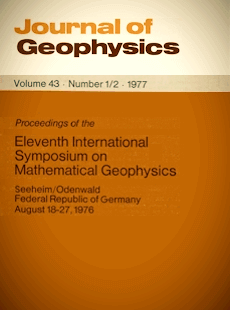Precursors to P'P' and upper mantle discontinuities
Article Sidebar
Published:
May 20, 1977
Keywords:
Precursor waves to P' P',
Upper mantle structure,
Array data
Volumes

Vols. 1-18 (1924-1944), ISSN 0044-2801
Main Article Content
E.S. Husebye
NTNF/NORSAR, Kjeller Norway
R.A.W. Haddon
Department of Applied Mathematics, University of Sydney, Australia
D.W. King
Department of Geology and Geophysics, University of Sydney, Australia
Abstract
In this paper the origin of precursors to P' P' with lead times greater than 50 s is investigated. Good NORSAR records of P'650P' and P'400P' for these arrivals as well as corresponding slowness estimates are presented. These phases are interpreted as done by others in terms of underside reflections from discontinuities or sharp transition zones in the upper mantle. An extensive search of 5 years of NORSAR records did not produce any significant evidence on P' P' precursor arrivals with lead times greater than 50 s other than those mentioned above.
 ARK: https://n2t.net/ark:/88439/y030873
ARK: https://n2t.net/ark:/88439/y030873
Permalink: https://geophysicsjournal.com/article/255
Article Details
How to Cite
Section
References
Adams, R.D. (1968) Early reflections of P' P' as an indication of upper mantle structure. Bull. Seism. Soc. Am. 58:1933-1947
Adams, R.D. (1971) Reflections from discontinuities beneath Antarctica. Bull. Seism. Soc. Am. 61:1441-1451
Bungum, H., Husebye, E.S., Ringdal, F. (1971) The NORSAR array and preliminary results of data analysis. Geophys. J.R. Astr. Soc. 25:115-126
Engdahl, E.R., Flinn, E.A. (1969) Seismic waves reflected from discontinuit ies within the Earth's upper mantle. Science 163:177-179
Haddon. R.A.W., Husebye, E.S., King, D.W. (1977) Origin of precursors to P' P'. Phys. Earth Planet. Int. 14:41-71
Husebye, E.S., King, D.W., Haddon, R.A.W. (1976) Precursors to PKIKP and seismic wave scattering near the mantle-core boundary. J. Geophys. Research 81:1870-1882
King, D.W., Haddon, R.A.W., Husebye, E.S. (1975) Precursors to PP. Phys. Earth Planet. Int. 10:103-127
King, D.W., Husebye, E.S., Haddon, R.A.W. (1976) Processing of seismic precursor data. Phys. Earth Planet. Int. 12:128-134
Richards, P.G. (1972) Seismic waves reflected from velocity gradient anomalies within the Earth's upper mantle. J. Geophys. 38:517-527
Whitcomb, J.H. (1973a) A study of the velocity structure of the Earth by the use of core phases, Ph.D. Thesis, Calif. Institute of Technology, Pasadena, 173 pp.
Whitcomb, J.H. (1973b) Asymmetric P' P': an alternative to P' dP' reflections in the uppermost mantle (0 to 110 km). Bull. Seism. Soc. Am. 63:133-143
Whitcomb, J.H., Anderson, D.L. (1970) Reflection of P'P' seismic waves from discontinuities in the mantle. J. Geophys. Res. 75:5713-5728
Adams, R.D. (1971) Reflections from discontinuities beneath Antarctica. Bull. Seism. Soc. Am. 61:1441-1451
Bungum, H., Husebye, E.S., Ringdal, F. (1971) The NORSAR array and preliminary results of data analysis. Geophys. J.R. Astr. Soc. 25:115-126
Engdahl, E.R., Flinn, E.A. (1969) Seismic waves reflected from discontinuit ies within the Earth's upper mantle. Science 163:177-179
Haddon. R.A.W., Husebye, E.S., King, D.W. (1977) Origin of precursors to P' P'. Phys. Earth Planet. Int. 14:41-71
Husebye, E.S., King, D.W., Haddon, R.A.W. (1976) Precursors to PKIKP and seismic wave scattering near the mantle-core boundary. J. Geophys. Research 81:1870-1882
King, D.W., Haddon, R.A.W., Husebye, E.S. (1975) Precursors to PP. Phys. Earth Planet. Int. 10:103-127
King, D.W., Husebye, E.S., Haddon, R.A.W. (1976) Processing of seismic precursor data. Phys. Earth Planet. Int. 12:128-134
Richards, P.G. (1972) Seismic waves reflected from velocity gradient anomalies within the Earth's upper mantle. J. Geophys. 38:517-527
Whitcomb, J.H. (1973a) A study of the velocity structure of the Earth by the use of core phases, Ph.D. Thesis, Calif. Institute of Technology, Pasadena, 173 pp.
Whitcomb, J.H. (1973b) Asymmetric P' P': an alternative to P' dP' reflections in the uppermost mantle (0 to 110 km). Bull. Seism. Soc. Am. 63:133-143
Whitcomb, J.H., Anderson, D.L. (1970) Reflection of P'P' seismic waves from discontinuities in the mantle. J. Geophys. Res. 75:5713-5728











